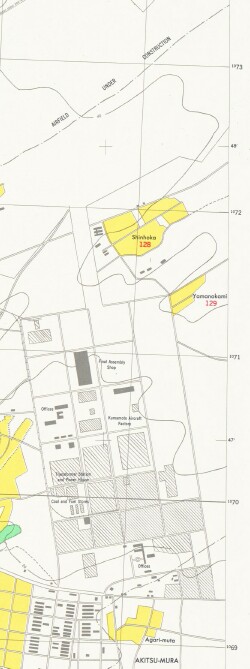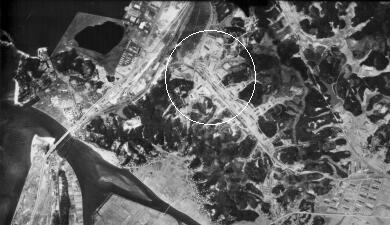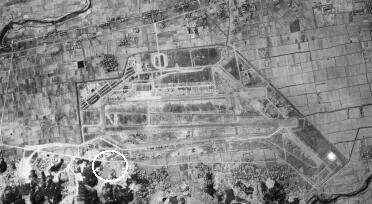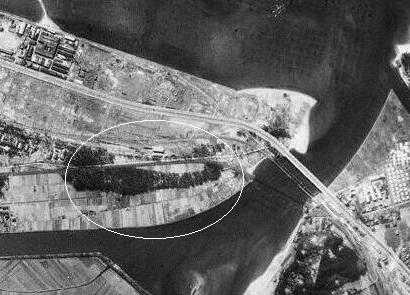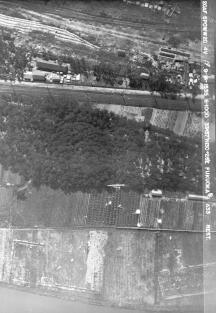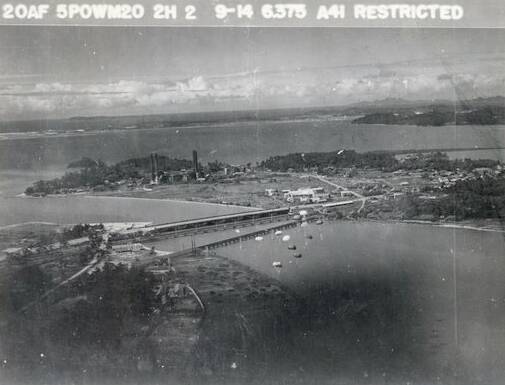This site is about the Prisoner of War camp that was in
Fukuoka during World War II. It was first located in Kumamoto from late
1942 and moved to three
other locations in Fukuoka City over a period of nearly two
years, from November 1943 until September 1945. Over 1000 American,
British, Dutch, Australian, Canadian and Norwegian POWs were interned
at Camp #1 during those years. Nearly 200 of those died here.
In the following pages you will read actual reports
from those who were at Camp #1, not only Allied affidavits used at the
International Military Tribunal for the Far East, but testimonies from
the Japanese as well, to help the reader assess both sides of the
story. I have neither deleted nor abbreviated any of the names or
facts. Declassified documents from the National Archives, Washington,
D.C., were scanned, run through OCR software, checked, and then retyped
where necessary. Typos are original, though some may be unintentionally
mine. Minor spelling changes have been made, though I did keep the
original spelling of the Japanese names with the proper spelling placed
between brackets [ ]. Notes that I've added here and there are also in
brackets.
For those of you who once lived in Fukuoka, after
reading these reports, testimonies, interrogations and affidavits, you
will no doubt get a different perspective on the city. I know every
time I passed by Fukuoka International Airport, I would think about
those who suffered building that airstrip, and those who rejoiced in
finding frogs, snails or grasshoppers in the rice fields, making for a
delicious roasted meal.
If you are a foreigner living in Japan, come August you
will be sure to notice the emphasis in the media regarding Hiroshima
and Nagasaki and the terrible A-bombs. Hopefully these pages I've put
together will add additional perspective.
I wanted to make this webpage in order to remember
those POWs who suffered here, in the city I have called home for the
past quarter century. Eventually I hope to place memorial plaques at
each of the former camp sites, cemeteries and crematoriums. It is
worthy that we remember those who unwillingly had to sacrifice so much
of their lives, both physical and mental suffering, much of which has
not healed even after all these years. We who never experienced war
will never really understand perhaps. But we can learn from what they
have written. Quite often while reading through and retyping these
affidavits I have been driven to tears, to the point of sobbing out
loud, and in a eerie way feeling as if I were there myself -- shivering
with the freezing, bleeding with the beaten, languishing with the sick,
enduring with the hopeful ones.
|
Prayer
for Prisoners of War
Look, O Lord God,
with the eyes of Thy mercy, upon all prisoners of war, especially those
known and loved by us. Preserve them in bodily health and in cheerful,
undaunted spirit.
Convey Thou to
them the support of our love on the wings of Thine own and hasten the
day of release; through Him who hath made us free eternally, Thy Son,
our Savior, Jesus Christ. Amen.
(This daily prayer for
prisoners of war was recently heard for the first time at St.
Margaret's, Westminster, in London, at a special service of
intercession. Written by the Dean of York, Rev. E. Milner-White, for
the Red Cross, it has now been adopted for general use in churches in
England. The prayer is based on the Second Epistle of St. Paul to the
Corinthians, chapter 3, verse 17: "Where the spirit of the Lord is,
there is liberty.") Source: American National Red Cross, Prisoners
of War Bulletin, Vol. 1 #2 July 1943
|
I do realize that the plight of the POWs in Japan is by
no means the worst of actions that man has leashed out on fellow man.
Were we to gather all the facts on the treatment of prisoners of
oppression throughout the centuries and milleniums, then we can make a
fair assessment of what was atrocious and what was justifiable, e.g.
guards beating POWs ferociously after an air raid. Worldwide, millions
have suffered and died at the hands of their captors. The POWs in Japan
were not unique. One only has to go back a few years, perhaps even only
a few months, or even weeks, to find similar atrocities that have
occurred around the world. Yuki Tanaka in his book Hidden
Horrors describes this well in his introduction, which you
can read below. If you were to mention the names of Auschwitz,
Buchenwald, Dachau to someone, they can probably associate these places
with atrocities. In contrast, mention Bataan, Sandakan, or
Kanchanaburi, and you will more than likely be greeted with blank
stares.
It must be stated emphatically that not all Japanese
commandants, guards and personnel were cruel towards their captives.
One former commandant,
now living in Fukuoka, treated POWs at the Nagasaki camp in a humane
manner. Cecil Parrott
tells of a number of Japanese who were kind to him. It's also worth
noting that not only were the Allies treated horribly as POWs, the
Japanese themselves were victims during the war -- some 600,000 being
imprisoned in Russian POW camps. Those who are loose with the epithet
"Japan-bashing" should read those accounts.
The following first-person accounts will certainly
reach deep, no matter what country you may be from. Naturally, as for
me, I think of those Americans who were here in Fukuoka. These were
some of my fellow countrymen, in a strange land with a strange
language, strange food and customs, away from everything they were used
to, being forced to live on the edge of what could barely be called
life, not knowing whether they would ever see their homeland again, nor
even when their last day would be. Just think of the daily routine
these men had to go through of not knowing what would happen to them --
day after day after day after day. The hope and fortitude of those who
survived, in the face of such depravity, is surely a quality we who are
more fortunate know very little of.
I am most aware and sensitive of the fact that there
are some ex-POWs that have no desire at all to remember those wretched
years of captivity, much less talk about their experiences. Past is
past -- they have gone on with their lives. It is not my desire to
bring up any painful memories, believe me.
Yet there are many former POWs who are now beginning to
write of their experiences and share their memories, and I am so glad
they have made that decision to share. The number is growing each year.
It could be that their children and grandchildren are encouraging them
to do so, or perhaps it is simply a final effort to deal with their
past, a form of ultimate therapy, so to speak. It's interesting that as
one gets older the desire to "leave a legacy" becomes stronger. We all
want others, especially our kids and grandkids, to know about what we
accomplished in life, the good we did, the sacrifices we made, so that
they can learn from our experiences and advice and hopefully avoid the
mistakes we made. It seems so many kids these days have made heroes out
of fantasy characters from the entertainment world. But here are some
real heroes for the youth of today.....
I think of George
Idlett..... Cecil
Parrott..... Lester
Tenney..... Frank
Lovato..... Don Versaw.....
Rodney Kephart.....
All these men, all ex-POWs, have recently written their
memoirs. I'm sure it was painful, yet they felt the need to tell others
about that pain. The remarkable thing I find in their recollections is
that they have no hate at all towards their former captors. In fact,
some of their closest friends now are Japanese.
They and so many thousands of other ex-POWs like them
know exactly what freedom is. Just ask them. Their love of that
cherished principle we take for granted can be seen so clearly as you
speak with them. August 1945 marked a special time in their lives.
Inwardly they surely must celebrate the day of their liberation with
more elation than any other day. Let us also, though, remember those
who have yet to experience their complete liberation from those
unspeakable memories.
"Finally,
finally,
finally,
someone has taken the time to pay attention."
--- Gavan Daws on main gist of letters from POWs,
in an article by James Dao
Here is an excellent tribute to all
former POWs from the July 2001 issue of The Quan. Their story must be told!
REMARKS
by Hon. Anthony J. Principi
Secretary of Veteran Affairs
American Defenders of Bataan and Corregidor
Hampton, VA
May 19, 2001
The
great historian David McCullough has written: "History is a guide to
navigation in perilous times." It is easy for today's statesmen to
chart an incorrect course by confusing a cinematic version of the war
with the war's true history. Hollywood would have it that an aroused
nation, awakened to its peril, armed itself after Pearl Harbor and
achieved victory after glorious victory, culminating in the Japanese
surrender on the battleship Missouri.
It is easy to tell the
story of our involvement in World War II as a tale of inevitable
victory. But that would result in a false understanding of history,
because it would omit the contribution that men and women like you made
at a time when our victory was far from certain. And your contribution
is a story that needs to be told.
Your story includes the
heroism of the 31st infantry regiment, and the 4th Marines, and the
28th Bomb Group, and the sailors at Cavite, and the other brave
American men and women stationed throughout the Western Pacific on
December 7, 1941.
All of these men and women woke up on December
8 cut off from their country and the world -- without a realistic
chance to defeat the enemy if they were not reinforced; without a
realistic prospect of receiving that reinforcement; and even without a
realistic chance to be evacuated.
Every new generation needs to
be told that Americans lived and fought in 1941 and 1942 with no chance
of victory for themselves, but with only the hope of delaying the enemy
while our nation woke up to the consequences of war.
Every new
generation needs to be told that three days after Pearl Harbor, the
Japanese sent three cruisers, six destroyers, and four transport ships
to attack the four hundred and forty-nine Marines on Wake Island. And
that the attackers were driven off by those Marines, and only a second
attack group with heavy cruisers, more destroyers, two aircraft
carriers and thousands of Japanese Marines could defeat these men.
At
the beginning of the war, only you and your comrades stood between the
enemy and victory. And you held the line, and did so magnificently,
even at a terrible cost. As General Mac Arthur said: "The Bataan
Garrison was destroyed due to its dreadful handicaps, but no Army in
history more thoroughly accomplished its mission."
Without you,
the sacrifices of the crew of the Arizona would have been in vain. The
Doolittle raid would have been an empty gesture. And the name of Dorie
Miller would have long been forgotten.
I am reminded of the
words of President John F. Kennedy. He said: "Without belittling the
courage with which men have died, we should not forget those acts of
courage with which men have lived. The courage of life is often a less
dramatic spectacle than the courage of a final moment, but it is no
less a magnificent mixture of triumph and tragedy."
Many men died at Pearl Harbor, at Wake Island, at Bataan and Corregidor, and throughout the Pacific theatre of war.
Many who were taken captive along with you died in the course of their captivity.
Next
weekend, on Memorial Day, we will once again honor those who died
alongside you, as we honor all our war dead. We honor them for their
faithfulness to our nation, for their service and sacrifice, and for
their unsurpassed courage.
But we must also honor you, who fought so valiantly and endured so much in the name of freedom.
Your story of steadfastness and loyalty again needs to be told.
We
must again tell the story of Bataan and Corregidor: of the 10,000
Americans of Bataan who surrendered and were led on the Bataan death
march, the thousand who died -- and the 9,000 who survived to face
years of brutal and deadly captivity.
We must again tell the
story of the men of Corregidor, kept prisoner for three and one half
years, and all who were held by the Japanese in conditions so horrible
that more than 87% of all those imprisoned died in captivity.
We
must remind a new generation of the slave labor you were forced to
endure, and the cruel and unusual punishments, and the medical
experiments.
Your story must be told because your courage -- and your heroism -- was what led us on to victory.
Most Americans have no idea what it is like to be in combat.
But you have all known combat -- both the physical kind, and the special kind that a prisoner of war faces.
In
combat, the enemy is largely unseen. He is somewhere out there, until
the moment the shooting begins, and even afterwards. And when the
shooting stops, the battle stops. There are opportunities for a hot
meal, for a furlough, even for reassignment once physical limits are
reached.
But to a prisoner of war, the enemy is everywhere. He
controls your fate, your future, even your bodily functions. You are at
war at every second. Your diet is always the same. You are never given
leave. You can never leave the combat zone. Even today, more than
fifty-five years after the end of your captivity, your lives are still
shaped by your experiences.
Your victory was measured in your
survival; and in maintaining your faith and your loyalty to your
country, when the reward for maintaining that loyalty was continued
starvation -- and death.
Your strong heart, great spirit, and
unyielding faith served as an inspiration to the rest of us. You placed
honor before everything, even before having a whole self.
You
absorbed with your own bodies the blows that were intended by our
enemies for our nation and its people, and you sacrificed your own
freedom for the freedom of the world.
And finally, you returned
from your service, regained your rightful place in our society, and
strengthened your families, your communities, and our nation through
your example of courage, and loyalty and continued good citizenship.
Your role in rebuilding America after the war is a story that also must be told.
We at the Department of Veterans Affairs honor your service, and are grateful for your sacrifices.
As
former Prisoners of War, you are entitled to special benefits from our
department. We recognize that the physical hardships and psychological
stress you endured in your captivity has had a life-long effect on the
health of many of you, and on your readjustment to society.
We
provide compensation for many disabilities that may have been brought
on by your captivity -- and are still looking for other linkages that
may become manifest as you age.
Our national outreach program
works to educate all former prisoners of wars about VA benefits and
services you may be entitled to.
And it is my highest priority
as Secretary to improve the timeliness and accuracy with which we
process benefits claims, both yours and those of every other veteran.
Some
of you may know that it now takes nearly nine months for us to process
the average claim for benefits. You have earned better service than
that. And you will get it.
Let me conclude with the words of television commentator Tom Brokaw. I'm sure most of you know his book, The Greatest Generation.
It is about the men and women who, like you, came of age in the 1940's.
This generation heard first-hand of your ordeals; was inspired by your
example, and rejoiced at your freedom.
You are among the greatest of the greatest generation. This is what Brokaw wrote of you, and those who served with you: "At
a time in their lives when their days and nights should have been
filled with innocent adventure, love, and the lessons of the workday
world, (American soldiers, sailors, airmen, Marines and Coastguardsmen)
answered the call to save the world from the two most powerful and
ruthless military machines ever assembled, instruments of conquest in
the hands of fascist maniacs. They faced great odds and a late start,
but they did not protest. They succeeded on every front. They won the
war; they saved the world."
So do not despair if you go to see
the movie about Pearl Harbor, and you do not recognize yourself and
your experiences in Hollywood's depiction of your war.
Remember
that others know of your loyalty to our country, your contribution to
our victory, and the many sacrifices you have offered for her freedom.
And of the strength you showed in resisting the enemy despite hopeless odds, and in continuing to resist despite your captivity.
When
they were asked what they needed, they asked only one thing. "Send us
more Japs," the commanding officer said. "Send us more Japs."
And
though these American troops knew that they faced certain captivity or
death, they fought as bravely and as well as any man in the United
States has ever sent into battle. Fifteen hundred Japanese were killed
in the assault on Wake Island. Only forty-nine Marines and three
sailors died.
And every new generation needs to be told that
fifteen days after Pearl Harbor, in Lingayen Bay, the Japanese
fourteenth army invaded Luzon. And though desperately short of food,
medicine and ammunition, the Battling Bastards of Bataan and the
defenders of the Rock fought ferociously until the following May.
Those
who fought on Bataan and Corregidor did more than resist the enemy to
the utmost of their ability. They stopped the Japanese in their tracks,
and gave our nation precious time to recruit and train the men and
women who would eventually win the war -- and build the ships, planes
and guns that were the tools we needed to win.
And they rallied
a nation made fearful by Pearl Harbor -- and reminded our citizens that
the American fighting man was the equal, or the superior, of any other
fighting man on the face of the earth.
The Japanese won great
tactical victories at the beginning of the war. We were not ready for
the preparations a totalitarian nation, shaped by leaders who glorified
war, had made for conquest.
Remember, too, that our ultimate
victory in World War II, and our continued prosperity today, rests in
no small measure on your accomplishments during that war.
And
that the tales of your great heroism will be told, again and again,
from generation to generation, for as long as our republic shall stand.
You
are but mortal men and women, but your steadfast courage and dedication
gave you the strength to achieve immortal acts. And those acts must be
acknowledged in perpetual stone.
Your story, your service, and
your sacrifice are irrefutable testimony that a memorial to the
veterans of World War II must be built on the National Mall in
Washington -- now!
May God bless all of you.
Be sure to visit the American Defenders of Bataan
& Corregidor site, and also the ADBC Descendants Group website.
|
 A. Gibbs
Report
A. Gibbs
Report ![]() Standard report of July 31, 1946
Standard report of July 31, 1946  B. Summary of
Investigation of POW Camp 1
B. Summary of
Investigation of POW Camp 1 ![]() Ramey investigation report of January 8, 1946
Ramey investigation report of January 8, 1946  C. Progress
Report Re Investigation of Camp Number 1
C. Progress
Report Re Investigation of Camp Number 1 ![]() Ramey and Humphreys report of January 6, 1946
Ramey and Humphreys report of January 6, 1946  D. Metcalf
Affidavit
D. Metcalf
Affidavit ![]() British POW's description of Kumamoto, Kashii and
Mushiroda camps
British POW's description of Kumamoto, Kashii and
Mushiroda camps  E. Vesey
Affidavit
E. Vesey
Affidavit ![]() British POW's description of Kashii and Mushiroda
camps
British POW's description of Kashii and Mushiroda
camps  F. Saunders
Affidavit
F. Saunders
Affidavit ![]() British POW's (Chief Commanding Officer)
description of all four camps
British POW's (Chief Commanding Officer)
description of all four camps  G. Kostecki
Affidavit
G. Kostecki
Affidavit ![]() American POW's (Chief Medical Officer)
description of Kashii, Mushiroda and Hakozaki camps
American POW's (Chief Medical Officer)
description of Kashii, Mushiroda and Hakozaki camps  H. Cooper
Report
H. Cooper
Report ![]() Excerpts from an American surgeon's report on
medical activities at Camp #1
Excerpts from an American surgeon's report on
medical activities at Camp #1  I. Lee
Affidavit
I. Lee
Affidavit ![]() British POW's description of Kumamoto, Kashii and
Mushiroda camps
British POW's description of Kumamoto, Kashii and
Mushiroda camps  J. Goodpasture
Check List
J. Goodpasture
Check List ![]() American POW's description of Hakozaki camp
American POW's description of Hakozaki camp  K. Memorandum
re Photos of Hakozaki Camp
K. Memorandum
re Photos of Hakozaki Camp  A. POW
A. POW
 B. Japanese
B. Japanese
 C. POW
Statistics
C. POW
Statistics  A. Vivisections
at Kyushu Imperial University
A. Vivisections
at Kyushu Imperial University 
 1. Articles on the crash, the vivisection
experiments, and the memorial
1. Articles on the crash, the vivisection
experiments, and the memorial 
 2. Statement by pilot, Marvin Watkins
2. Statement by pilot, Marvin Watkins 
 3. Interrogation
of Marvin Watkins
3. Interrogation
of Marvin Watkins 
 4. Watkins Statement of December 10, 1948
4. Watkins Statement of December 10, 1948 
 5. Letter from Marvin Watkins to Mrs. Dale
Plambeck
5. Letter from Marvin Watkins to Mrs. Dale
Plambeck 
 6. Message from Marvin Watkins to Taketa City
6. Message from Marvin Watkins to Taketa City  B. Beheading
of airmen
B. Beheading
of airmen 
 1. At Fukuoka Municipal Girls' High School
1. At Fukuoka Municipal Girls' High School 
 2. At Aburayama
2. At Aburayama 

 a. Interrogation
of Itaru Bajiri re August 10, 1945 incident
a. Interrogation
of Itaru Bajiri re August 10, 1945 incident 
 Summary of Japanese War Crime Tribunal
sentencing of Japanese personnel for Vivisection
and Aburayama incidents
Summary of Japanese War Crime Tribunal
sentencing of Japanese personnel for Vivisection
and Aburayama incidents  C. B-29
crashes & airmen killed
C. B-29
crashes & airmen killed 
 1. Interrogation
of Gunji Haraguchi re B-29 crash in Yokoyama, Yame-gun
1. Interrogation
of Gunji Haraguchi re B-29 crash in Yokoyama, Yame-gun 
 2. Air
Strikes against Fukuoka & Kyushu (TARGET: FUKUOKA)
2. Air
Strikes against Fukuoka & Kyushu (TARGET: FUKUOKA)  D. Bataan
Death March
D. Bataan
Death March 
 1. Death March Tales by Ray
Thompson
1. Death March Tales by Ray
Thompson 
 2. Bataan by George Idlett
2. Bataan by George Idlett 
 3. My Hitch in Hell by Lester
Tenney
3. My Hitch in Hell by Lester
Tenney  A. American
A. American  Affidavits A
- C
Affidavits A
- C  Affidavits D
- H
Affidavits D
- H  Affidavits J
- P
Affidavits J
- P  Affidavits R
- W
Affidavits R
- W  The Hansen Story
The Hansen Story
 The
Shreve Diary
The
Shreve Diary  Lt.
Col. Jack Schwartz, Medical Officer
Lt.
Col. Jack Schwartz, Medical Officer  B. British
B. British  Affidavits A
- D
Affidavits A
- D  Affidavits E
- L
Affidavits E
- L  Affidavits L
- W
Affidavits L
- W  Capt.
William P. Wallace, Royal Army Medical Corps
Capt.
William P. Wallace, Royal Army Medical Corps  Reuben
Eastham, Bombardier
Reuben
Eastham, Bombardier  C. Dutch
C. Dutch  Medical
Officer Jan Frederik de Wijn
Medical
Officer Jan Frederik de Wijn  Gerry
Nolthenius
Gerry
Nolthenius  D. Australian
D. Australian  Pte.
Jack Dilger
Pte.
Jack Dilger  Sgt.
Peter French
Sgt.
Peter French  Gnr.
Geoffrey Underwood
Gnr.
Geoffrey Underwood  A. Commandant:
Yuhichi Sakamoto
A. Commandant:
Yuhichi Sakamoto ![]() Summary of Information, Oct. 22, 1945;
Interrogation of Oct. 29, 1945
Summary of Information, Oct. 22, 1945;
Interrogation of Oct. 29, 1945  B. Medical
Officer: Masato Hada
B. Medical
Officer: Masato Hada ![]() Affidavit of Jan. 2, 1946; Review of the Trial of
Masato Hada
Affidavit of Jan. 2, 1946; Review of the Trial of
Masato Hada  C. Interpreter:
Takeo Katsura
C. Interpreter:
Takeo Katsura ![]() Lengthy handwritten affidavit of January 20, 1946
Lengthy handwritten affidavit of January 20, 1946
 D. Guard:
Hajime Honda
D. Guard:
Hajime Honda ![]() Interrogation of May 28, 1946
Interrogation of May 28, 1946  Summary of Japanese War Crime Tribunal
sentencing of Japanese personnel in Fukuoka
Camp Group
Summary of Japanese War Crime Tribunal
sentencing of Japanese personnel in Fukuoka
Camp Group ![]() A. Prisoner of War Supply Missions
to Japan
A. Prisoner of War Supply Missions
to Japan ![]() B. Prisoner of War Encampments
B. Prisoner of War Encampments
![]() C. Recovery
and Rescue of Prisoners of War
C. Recovery
and Rescue of Prisoners of War ![]() D. John
Bankston Collection -- Photos from Nagasaki, Sept. 1945
D. John
Bankston Collection -- Photos from Nagasaki, Sept. 1945
![]() E. Arrowhead
Pictorial -- Occupation of Japan by 2nd Marine Division
E. Arrowhead
Pictorial -- Occupation of Japan by 2nd Marine Division
![]() F. Fukuoka Targets
- Japanese Air Target Analyses
F. Fukuoka Targets
- Japanese Air Target Analyses ![]() G. Kyushu Airplane
Company Report
G. Kyushu Airplane
Company Report ![]() H. Civilian Internment Camps in
Japan
H. Civilian Internment Camps in
Japan ![]() I. Chronology Chart of
Civilian Internment Camps: Internee Strength & Movement
I. Chronology Chart of
Civilian Internment Camps: Internee Strength & Movement
![]() J. Foreign Resident Population
in Japan: Nationality and District of Residence
J. Foreign Resident Population
in Japan: Nationality and District of Residence  A. Lawsuits
A. Lawsuits
 B. Memorials
B. Memorials

 1. Mizumaki Cross Memorial
1. Mizumaki Cross Memorial 
 2. Soto Dam
2. Soto Dam 
 3. Taketa "Sky Martyrs" Monument
3. Taketa "Sky Martyrs" Monument 
 4. Sanko Peace Park
4. Sanko Peace Park 
 5. Takachiho "Prayer for Peace" Monument
5. Takachiho "Prayer for Peace" Monument 
 6. Kihoku Crash Site Monument
6. Kihoku Crash Site Monument 
 7. Naoetsu Peace Memorial Park
7. Naoetsu Peace Memorial Park 
 8. Japan-U.K. Friendship Monument, Mukaishima
8. Japan-U.K. Friendship Monument, Mukaishima ![]()
![]() 9. Emukae Memorial, Fukuoka Camp #24
9. Emukae Memorial, Fukuoka Camp #24
![]()
![]() 10. Nagasaki Memorial, Fukuoka Camp #14
10. Nagasaki Memorial, Fukuoka Camp #14

 Other
Memorial Sites in Japan
Other
Memorial Sites in Japan 
 B-29
Memorial Sites elsewhere in Japan
B-29
Memorial Sites elsewhere in Japan  C. Assorted
Articles and Pages
C. Assorted
Articles and Pages  Cecil
Parrott
Cecil
Parrott  Neil
MacPherson
Neil
MacPherson  Gerry
Nolthenius
Gerry
Nolthenius 